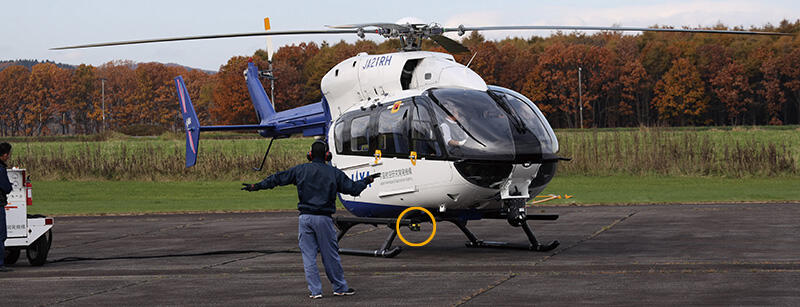Aeronautical Technology Directorate
Automatically Avoiding Collisions
Helicopter Safety Technology
The Aeronautical Technology Directorate is engaged in research on enhancing helicopter safety. Helicopters are used for various purposes, such as search and rescue and transportation of goods. However, they sometimes come into contact with obstacles, in particular when flying near terrain at low speed or hovering (staying in one place in the air), which can lead to accidents. To prevent such accidents, we are working to develop the technology to automatically avoid collisions with obstacles.
Mr. ISHII Hirokazu, who supervises the research, gave a brief account of the technology:
"In mountainous areas, for example, when hoisting people from the above, rescue helicopters sometimes need to hover in the vicinity of obstacles such as mountain surfaces and trees. We aim to develop a system to automatically control the motion of the helicopter so that it will not get any closer when it is likely to get close to obstacles."
This research has three technological themes: detecting an obstacle, issuing a warning to the pilot, and controlling the attitude of helicopter to avoid a collision with the obstacle.
"For the detection of an obstacle, we confirmed the effectiveness of the lidar (obstacle sensor) in the experiment in which it was mounted on the research helicopter. The next step is to detect obstacles in various situations through combinations of radars and cameras," said Mr. ISHII. For the issuing of a warning to the pilot, after saying "I can't say something concrete because it is under study," he continued to say as follows:
"Visual methods include the warning to notify that an obstacle is near, the method to show the direction of an obstacle, and the method to display the shape of an obstacle three-dimensionally. For these methods, in addition to a normal display, a helmet-mounted display (HMD) for which information can be projected to the visor of the helmet, is sometimes used. Furthermore, a combination of warning sound and a vibration of the control stick can be considered as a possibility."
For the avoidance of obstacles, we are at the stage of having pilots evaluate a trial system using a flight simulator and confirming, through flight tests of JAXA's research helicopter, whether computer can correctly calculate the action to avoid obstacles based on actual obstacle information. The next step is to add the function of automatically controlling the helicopter in accordance with the calculation results. Mr. ISHII said enthusiastically, "Adding this function, we will be able to conduct a flight demonstration designed to automatically avoid actual collisions with obstacles." This research will continue to be conducted aiming for helicopters to play a role more safely and widely.


Profile

|
|
|---|
All the images are copyrighted ©JAXA unless otherwise noticed.
- Home>
- Global Activity>
- Public Relations>
- JAXA’s>
- JAXA's No.81>
- Automatically Avoiding Collisions Helicopter Safety Technology